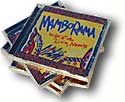![]()
Buy
Mamborama's
Night of the
Living Mambo
|
With the basic tracks done, we brought in Jorge Luis Guerra from Trabuco to play guiro. Jorge played all five tunes we had done at that point in one take each. He was done in half an hour. That guy is truly amazing. Rock solid. David Bencomo (flute player with Trabuco) played the flute solos. I explained to him that the digital recorder had virtual tracks, the capability to make several takes, and he could play as many solos as he wanted. This usually puts the player at ease, since they don’t have to be on the spot to play a perfect solo the first time. David played five solos on Esperando la luz, and each one got better, even though the first one was marvelous. The fifth one, however, was the stuff. David listened to it back, and said, “¡Ya!” That’s the one you hear on the album. But on the solo on Ven a bailar, David said “¡Ya!” on the first take—it was killer, and he knew that there was no point in trying to top it, and so did I. Great player.
After the coros to Estar en Cuba were done, Indio sang it for me as it played back in the studio. I had heard the lyrics before, but this was the first time I heard it with the music and with the coros. It sounds corny, but I had tears in my eyes, I was so happy. Really. Now at this point, normally I would have recorded the horns, so that El Indio would have the whole orchestration to react to when he did the vocals. But I was running out of time. Doing horns right takes a lot of time. I had monster horn players in LA, but I didn’t have El Indio in LA. We decided to do the vocals. I asked Indio which tune he wanted to start with. He said, “La Gata Loca, because I don’t know anything about this song.” I had forgotten to give him the demo! We went over the lyrics, and he and David corrected my numerous grammatical errors, and then we recorded the tune. David had the score, and sang the melody to Indio phrase by phrase in solfege, something I wish I had learned. Indio said he sang better with a little rum, so Hector went on the mad dash for another bottle of Havana Club. After we got the cuerpo and the first coros down, I showed him where his guias would go. He said, “give me five minutes,” and sat down and started writing down ideas. What you hear on the album is all first take. The guy is absolutely brilliant. Next came the tunes he was more familiar with, because he wrote the lyrics: Ven a bailar and Estar en Cuba. All of them are first takes. Unbelievable. As slow as things had progressed before, now they were moving faster than I could plan ahead, and I realized that night when I was having dinner with Marcos and his wife that I didn’t have much planned for the next day. I asked him if he knew a trumpet player that could play the solo on La Gata Loca. He said, no problem, I think I can find someone. The next day he shows up at the studio with Julio Padrón! I about fell out of my chair, I was so surprised. Julio, if you don’t know, is one of the best jazz trumpeters in the world, let alone Cuba. So I had the honor to record him and later sit in with his group at La Zorra Y El Cuervo. Gracias, Marcos! Like all the best players in Cuba, Julio is sincerely humble. I think that’s why they get so good. They never sit back and think, “I’m the shit.” They’re always learning, always moving ahead. |


Some good Cuban web sites:
CanalCubano
This site actually lists who's playing where in clubs all over the island.
This info can be hard to find when you're there.
CubaSi
click on the "multimedia" button and listen to live Cuban radio
and TV.
Cubaweb.cu
A general info site, with a slant towards tourism and news.
FolkCuba.com
If you have broadband, check out their Flash site.
Recetas
Genuine comida criolla recipes direct from Cuba. Spanish only.



 I
asked El Indio, David and Ricardo Amaray (one of the other great
lead singers from Trabuco, he’s the one singing Tú
me dijiste mentiras) to sing coros. Indio took over and directed
the coros like the maestro he is. He came up with the harmonies
and rehearsed the guys. I became the engineer at that point, Indio
was producing, and doing great. He brought in a wonderful female
singer for Estar en Cuba, because the top part was too high. The
girl is only nineteen, but has an amazingly powerful voice. Everyone
who hears the track says, “Who’s the girl?” She is
Anisley De Las Mercedes Rodríguez Venerio, a name as big
as her voice.
I
asked El Indio, David and Ricardo Amaray (one of the other great
lead singers from Trabuco, he’s the one singing Tú
me dijiste mentiras) to sing coros. Indio took over and directed
the coros like the maestro he is. He came up with the harmonies
and rehearsed the guys. I became the engineer at that point, Indio
was producing, and doing great. He brought in a wonderful female
singer for Estar en Cuba, because the top part was too high. The
girl is only nineteen, but has an amazingly powerful voice. Everyone
who hears the track says, “Who’s the girl?” She is
Anisley De Las Mercedes Rodríguez Venerio, a name as big
as her voice.